Ready to invest in a rake for your gardening endeavors? Enhance your understanding of the various types of rakes available to ensure a wise choice. Surprisingly, many gardening novices are unaware of the broad spectrum of rakes offered on the market.
There’s no universal, all-purpose rake design, thus knowing precisely what to select based on your requirements is crucial. We’ve compiled a thorough guide outlining the key types of rakes you’ll encounter.
Our guide goes beyond simply listing the rake types. It delves into their specific functions, enabling you to choose the optimal rake for your residential or commercial needs.
Table of Contents
What is a Rake and its Purpose?
A rake is a garden and landscaping tool designed to use for various gardening, landscaping, and even agricultural use. It is typically attached to a large plastic, metal, or wooden head with teeth held together by a long handle.
A rake was officially patented and introduced on the market by Edmund Brown, although earlier versions existed before. The patented version enjoyed the addition of metal teeth, which allowed for smoother raking, preventing debris clogging.
A rake offers a variety of applications, thanks to its versatile build. Here are the common functions of a rake, depending on its design;
- Ideal for a range of gardening, lawn, home improvement, and construction applications
- turning lumped, compacted, and hard soil for better growing conditions
- Mixing fertilizer and compost
- Spreading mulch for moisture and soil quality retention
- Removing weeds and other ground coverings
- Gathering and removing leaves, grass clippings, and other garden debris
- Spreading ground covering like chippings and bark
- Spreading gravel and pebbles
- Spreading wet concrete during construction
- Tamping and compacting soil
- Removing pond and lake weeds and other aquatic plants
What are the Parts of a Rake?
No matter the design or type, a rake is typically made of a head with teeth and a handle.
Handle: A rake handle is long and designed to be held by both hands when the user is standing. Handles can be made from plastic, metal, wood, or other materials, although wood and plastic are a popular choice. You will also come across hand rakes that tend to have shorter handles to use closer to the ground. A handle is a very important part of a rake as it provides you with much of the power and strength to rake. Always choose an ergonomically designed rake handle with a high grip design for the best results.
Head: The rake head forms the bottom part of the rake, connecting to the handle while holding the teeth or tines. Depending on the rake type, you can find small to large rake heads. While small heads are built for accessing smaller areas, larger or wider heads perform larger tasks, like handling lawn grass.
Teeth/tines: Rake teeth, tines, or prongs from the front end of the rake. They are what do the actual ground job and come in varying designs based on the rake type. You can find soft, rigid, flexible, barrow, wide, long, and short tines, to name a few.
Hanging hole: Some rakes are designed with a hanging hole to allow for safer storage. Hanging the rake in your shade or garage, ideally in a rake rack, protects the head and teeth, prolonging its durability.
Rakes come in a variety of types, designs, and styles. However, you can find a range of additional features, despite the type of rake. These extra features are usually intended to improve the functionality and effectiveness of the rake.
For instance, you can find rakes fitted with adjustable, angled, or ergonomic padded handles. Other rakes even feature telescopic handles, allowing you to adjust the handle based on your needs. An adjustable handle improves the rake’s versatility.
In some cases, it even eliminates the need to invest in more than one rake. Similarly, you can also find rakes with adjustable heads, letting you adjust the head and tine width to suit your project needs. On the other hand, rakes with wheeled heads facilitate more comfortable and convenient jobs, particularly for those with pain problems.
Further, you will also find rakes designed with built-in or removable tamps, ideal for breaking up or leveling compacted soil or rocks.
27 Common Types of Rakes Available on the Market
Different types of rakes are built for varying outdoor projects. Further, rakes even come in specialized designs for particular tasks and conditions. Here is a complete list of the most common types of rakes you can find;
A rake hoe is a special 2-in-1 rake and hoe tool. These gardening tools typically feature a garden rake on one side and a hoe on the other. In theory you could eliminate buying a rake and a hoe, but in reality the width is not large enough to give you raking functionality.
You can however use it to move the dirt around that you just broke up with the hoe.
As its name suggests, a power rake is a motorized rake, designed to run on an electric or gas-powered engine. Due to the extra power, power rakes are faster and more convenient to use. Unlike manual rakes, power rakes work by simply pushing them across the intended location after powering them.
They do the rest automatically, whether raking grass or removing thatch and debris. In addition to the automated power feature, these rakes are usually fitted with a rotating head with sturdy teeth (commonly made of metal) to work deeply into the ground.
This makes it easier to thoroughly remove thatch, dead leaves, and twigs. Standard designs let you clear out the garden and then, use a manual leaf scooping rake to gather, remove and discard the grass. However, more advanced designs come with collection bags to handle the tedious workload for you.
Power rakes are effective for thoroughly cleaning the garden or yard to allow for optimal ventilation. Moreover, most power rakes are typically designed to deal with the grass and debris part of the garden, although you can find a few specialized ones and those built to deal with soil and rocks.
A hand rake is a smaller version of a standard garden rake. It is typically designed with a smaller head with three rigid teeth and a shorter handle. The small size also makes single-hand maneuvers easy without risking injury or fatigue. Due to its smaller size, a hand rake is intended for detailed work.
Hand rakes come in handy when working on borders, flower beds, or plant pots. You can also use them to pull out weeds and remove old roots, and topsoil layer debris. Further, a hand rake is also ideal for turning beds, removing loose surface stones, and tilling the soil.
A garden or dirt rake is a standard multipurpose rake you will find in any home garden shed or garage. A garden rake is also an essential tool for a vegetable or flower gardener. A garden rake is built with a long and straight handle attached to a wide and stiff head at a right angle with equally stiff and short teeth.
The stiff and short teeth design makes them perfect for handling tough garden jobs. Additionally, a dirt rake can have straight or curved tines ideal for targeting compacted and tough soil. A garden rake head is commonly made using metal or steel while the handle is made from wood, metal, or plastic.
The head and tine design also makes it easier to handle large debris, such as weeds and other ground coverings. Nonetheless, a garden or dirt rake is popularly built for tilling and turning soil during preparation for planting and seed sowing.
Alternatively, the stiff nature of the rake lets you spread ground coverings, such as chipping and bark. If you find garden rakes that come with tampers, you can also use them to tamp the soil.
Note: A garden or dirt rake is commonly fitted with rigid tines, making it an unsuitable tool for leaf raking. This is because the rigid and closely lined tines can easily get stuck on the grass. You have to opt for a leaf or lawn rake to deal with leaves.
A bow rake is sometimes likened to a garden and dirt rake. But, it has slightly varying functions. A common tool for a gardener, it is built to handle debris that is slightly heavier than leaves. These include leveling soil or smaller rocks.
You can also use the rake to prepare for mulching or hardscaping projects. As its name suggests, it has a wide head with shorter and thicker tines, made from metal. Bow rake tines are also stiff to allow them to handle heavier materials.
6. Push Broom Rake
A push broom or claw broom rake is a commonly known rake, integrated with a 2-in-1 rake and broom design. The broom rake uses teeth to grab onto leaves and similar debris for more effective collection. This rake has a dual functionality, using the rake part to push debris and collect it into a pile and then, using the broom part to sweep it away.
This rake is perfect for gardeners who want to prepare the debris for mulching or discard it nearby. It also comes in handy for neater debris collection before transferring it into a collection bucket or container. Since the rake integrates a broom, it is unsuitable for areas with dirt or uneven rough surfaces.
Instead, it works perfectly in patios, sidewalks, and driveways, where you will find fallen leaves and similar small debris. But, you can also use it to collect or move mulch and compost in your yard or garden.
Specialized Rakes
A landscaping rake is a specialized tool designed for professional gardeners and professional landscapers to use and comes in handy for various yard tasks. They are built with a long handle, a wide head, and short tines. You can use a landscape rake for large jobs, such as leveling soil, spreading and mixing compost, spreading gravel and stone, mulch, and other organic items.
While this is a less common function, a landscaping rake can also be used for removing pond and lake weeds or other aquatic plants as well as gathering leaves and similar garden debris.
A shrub rake is simply a miniature-sized leaf rake and is usually made of metal or plastic. It accommodates plastic due to its relatively lightweight tasks. This specialized rake is designed with short and fewer teeth on a narrow head to create a narrow fan shape allowing it to reach into narrower spaces where a leaf rake can’t. You can use a shrub rake in areas, such as below shrubs or around the fence.
If you have berries growing in your garden, a berry rake is worth investing in. Also known as a berry picker, a berry rake functions just as its name suggests. It is designed to collect berries from the plants, protecting you from the thorns on berry plants.
Berry rakes also make it easier to pick more berries in a shorter period, eliminating the tedious manual work of picking them one by one. The specialty rake is fitted with small and narrow tines that pull the berries from their branches without damaging them. It is also adequately sized to ensure you pick berries that are ready for harvest alone.
Further, a berry picker can get to hard-to-reach parts of the trees that would otherwise cause you to abandon the berries without a picker. You can also find more sophisticated berry pickers fitted with collection containers where the berries fall into to make your job even easier. With a collection container or bucket, you don’t have to worry about making a mess on the ground, either.
A lawn rake is commonly associated with a leaf rake and is even used interchangeably. But, these two rakes are pretty different from one another. A lawn rake tends to be more versatile than a leaf rake and can be used as a fan or spring tine rake. It is built with thin and long tines that spread out to form a fan-like design.
A longer handle allows for easier use and longer reach. Moreover, the times bend near the ends to create a slight curve for easier debris collection and gathering. Made from metal or plastic, the lawn rake teeth are usually flexible to make the rake gentler on the ground. But, compared to lead rakes, these teeth are stronger to give the lawn rakes their versatility.
As a general rule of thumb, a lawn rake should be strong enough to use over extended periods without breaking. Yet, they still have to be simple to maneuver. Some of the key functions of lawn rakes include gathering leaves, grass clippings, and other lightweight garden debris. You can also use a lawn rake to remove moss and thatch if you don’t own a more expensive thatch rake.
A lawn rake can also be used to spread topsoil and fertilizer on your lawn or flower beds or remove lightweight weeds and other aquatic plants on the top part of a pond. Additionally, a lawn rake is strong enough to disrupt old roots and loosely rooted weeds and scratch soil surfaces. However, this is only possible if the soil isn’t as compacted. Only a dirt or garden rake can handle compacted and other types of stubborn soil.
A field, baseball infield, or aggregate rake is a specialized rake used by groundskeepers in baseball fields. The rakes feature a long handle attached to an ultra wide head and narrowly spaced ultra thin and short tines. A field rake is commonly made of metal to withstand its field applications. It is commonly used to remove debris, soils, rocks, and stones. This, in turn, keeps the field more presentable and safer to play on.
A leaf rake is primarily designed to move and gather leaves and grass clipping. You can also use a leaf rake to spread thin layers of topsoil, fertilizer, or grass seeds on a lawn or garden. Their main difference from lawn rakes is that they can’t handle anything heavier than leaves. They have a similar design to that of a lawn rake with the tines bent at a 90-degree angle for better grip collection. They are also commonly made from plastic.
Note: Avoid using a leaf rake with thinner or weaker plastic tines on uneven ground for spreading topsoil or fertilizer. An uneven surface increases the risk of damaging the tines.
A leaf scoop rake does exactly what it sounds like it does. This specialty rake features a scooping feature that allows it to collect and discard leaves into a collection bin or container. A scooper is usually made of plastic tines and features a curved edge design to hold the leaves more securely.
A leaf scooper comes in handy for gardeners with back problems that don’t want to bend to pick the leaves from the ground. However, you can find handheld ones for gardeners that want to quickly collect the leaves and move on to other tasks.
Leaf scooping rakes come in three main sub-categories, including single-headed, double-headed, and head rakes. A single-headed leaf scoop features a single-head design that folds in to grab leaves. You can also use it as a leaf rake to sweep, gather leaves in a pile, and scoop them into a bag or bin. As the name suggests, a double-headed scooper features two heads attached to a handle or a tong-like design. This makes it easier to grab the leaves and transfer them into a collection container or bin.
A handheld leaf scooper, on the other hand, features two rake headpieces with rear loop handles to attach your hands. This type of leaf scooper allows you to collect a larger amount of leaves by eliminating the handle. This means that you have to bend to the ground to pick them up. But, it allows for a more thorough and neat job, especially when there are a lot of leaves.
14. Hay Rake
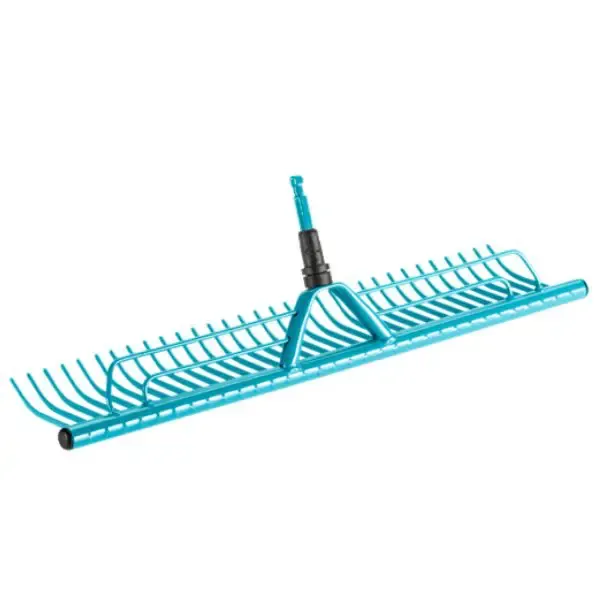
As the name suggests, a hay rake is specially designed to handle hay. It is generally used to collect hay to use for bailing. You can also use a hay rake to turn hay over and spread it for efficient and thorough drying. However, you can also use it for other large scale agriculture jobs.
A hay rake resembles a landscaping rake, but with a wider head and stiffer teeth. This design allows the rake to cover more ground without the risk of breaking or snapping. You can also find some hay rake varieties that come with attachments to mount on a tractor for easier hay collection.
A thatch, dethatching, or scarifying rake is built to address thatch buildup. Thatch refers to tight intermingled layers of leaves, stems (living and dead), and roots that grow between a layer of grass and soil. Now, a thatch rake helps you remove thatches for a healthier garden.
When left unremoved, thatch creates the perfect environment for pest and microorganism activity, making the area vulnerable to disease. Excessive thatch can also prevent the proper uptake of nutrients, water, and air from the plants, making them vulnerable to drought and disease.
A thatch rake is usually made from metal or steel to give it enough power to pry out the thatch on the garden or lawns. You can find a single or double-sided thatch rake head. The double side offers one part for pulling the thatch out and the other for removing it.
On the other hand, its tines feature a sharp blade-like design to make it easier to cut and pull out the thatch. But, even with this intense design, a thatch rake is built to prevent damaging the healthy grass. This explains why a thatch rake is important for effective and non-disruptive jobs.
You can also use a dethatching rake to remove moss in grassy areas. Further, the string and sharp tines of a thatch rake make it effectively break up compacted and digging through soil lumps. You can use it to cut through the hard soil to remove weeds and debris.
A garbage rake slightly resembles a garden rake. But, it has longer tines widely spaced. Commonly made from metal, it is built for collecting large amounts of debris and garbage in the garden or yard. Its widely spaced teeth design makes it easier to move and grab debris from the ground. On the other hand, its long handles allow it to access hard-to-reach areas.
During heavy snow season, you can also use this garbage rake to clear snow outdoors, from the driveway and sidewalk. It is, however, unsuitable for roof use as its metal construction and sharp tines can easily damage the roof. Instead, you want to invest in a specialized and more forgiving roof rake for your roof.
A roof rake, usually built from lightweight plastic, is designed for removing snow and debris from the roof of a house or small building. Due to the nature of natural debris found on the roof, a plastic roof rake is enough for efficient removal. Using a flexible and lightweight plastic roof rake also prevents scratching or causing any other damage to the roof material.
Additionally, the lightweight plastic material makes it safer to use the roof rake overhead. So, in the event of an accident, you don’t have to worry about a serious injury you would otherwise suffer from materials, like steel or wood. Lastly, a lightweight plastic rake is much more forgiving over extended periods, preventing premature hand, neck, and back fatigue.
The rake’s tines are usually long and thin, allowing the rake to access difficult-to-reach parts of the roof. The length also lets you access a wider area of the roof without frequent movement to reduce the risks of accidents. Remember, you will be operating the rake while standing on a ladder.
Therefore, you need as much convenience and functionality as possible. If you live in areas with heavy snow during winter or large trees expelling leaves during fall, a roof rake is an essential tool to have in your shed.
A stone rake functions like a garden or dirt rake. But, as its name suggests, it is built for heavy duty tasks, particularly those involving stones. Due to its heavy duty functions, a stone rake is made from materials, such as metal or steel.
Compared to a garden rake, it has a wide head with narrow, and widely spaced rugged tines. To prevent possible damage and loss of power, their rake tines are pretty stiff. Their choice of materials and extra building attention make stone rakes slightly more costly than regular rakes. A stone rake is perfect for handling stone, spreading stone material, and even mulch.
As you would’ve noticed by now, rakes aren’t limited to just gardening work. Other types of rakes boast functionalities that extend to other home improvement efforts. Concrete rakes are among these rake types.
Rather than gardening or lawn care, concrete rake focuses more on construction and home improvement. A concrete rake is primarily designed to move and level wet concrete over patios, paths, or walkways during a building or home improvement project.
Made using high tensile and heavy duty metal, like steel or aluminum, a concrete rake features a dual-sided design. One side has a flat edge intended for smoothing concrete while the other is curved for scooping the concrete.
Like a stone rake, a gravel rake is built for gravel. Surprisingly though, a gravel rake resembles a landscape rake with a narrower head. Since it is designed to deal with rugged gravel, gravel rake is made from heavy duty metal, like steel. This also makes it easier and safer to move pebbles and slightly larger stones.
Comparative to stone and gravel rakes, a tarmac or asphalt rake is built for handling tarmac or asphalt-related jobs. This specialty rake looks like a garden rake, but much more superior in strength. Its primary job is to avoid breaking or snapping during heavy duty jobs.
This rake is built with a wider head and stronger teeth. You can use it for spreading various heavy duty materials. A good example is spreading and leveling ground coverings, such as asphalt concrete, pebbles, or warm tarmac. However, due to the similar designs, you can also use tarmac rakes as garden rakes on regular lightweight coverings, like bark chippings.
Furthermore, the heavy duty rake can be used for breaking up and tilling the most stubborn lumped and compacted soil, removing stones, and other debris. You will also find contractors using tarmac rakes when preparing small sites for construction or improvement projects.
You’ve already seen several rakes that can handle some pond and lake work, particularly removing weeds. However, if you have more in-depth pond or lake jobs, you want to invest in a lake rake. Also known as a pond or algae rake, a lake rake is designed to collect weeds, moss, algae, and other aquatic plants to clean a pond or lake.
A lake rake features a long high grip handle (to prevent slipping from wet hands), a wide head, and thin, short tines. But, you can find some models built with a flotation device for easier operation. Lake rakes are pretty simple to use, all you do is put it on the surface of the water where the debris is and drag it to pull out the debris.
You have an extensive water source; you can tie the rake to a boat, hold it down, or use its floatation device to thoroughly collect the debris across the water area. A lake rake is an important tool for keeping your water surroundings clean.
A fire rake is not associated with garden or lawn care use. Instead, the specialty rake comes in handy during fire emergencies. So, it is an invaluable tool in fire-prone areas, like the west coast where drought is common.
In fact, a fire rake is an important tool for firefighters. A fire rake has a short to long handle design with a thick and narrow head and wide serrated blade-like teeth. It functions by pushing soil into a fire to help extinguish it or from progressing closer to your home.
Due to their functions, fire rakes are made using metal and never wood. The heavy duty metal also makes it easier to push large amounts of soil without breaking or snapping the rake. You can choose a short-handled one for closer jobs, when needed, or long handled varieties to allow you to work at a safer distance from the fire.
No, an ash rake isn’t used after extinguishing a fire! Quite the contrary, it is used in other circumstances involving fire. This specialized metal rake features a small head and shorter handle and is designed for jobs around the fireplace or grill. Whether you want to adjust the fire or wood, this ash rake lets you do so without getting burnt. You can also use it to clean our grills and fireplaces by removing and scooping out ashes.
A poop scoop rake is built for handling poop and waste. An important tool for pet owners, it allows for easier pest waste management. You can use it indoors and outdoors. Poop scoop rakes come in various designs. This includes one with a scoop pan and a small rake, resembling a broom and dustpan. Additionally, their handles are normally long to eliminate the need for bending.
A Zen garden rake is completely different from a regular garden rake. This specialty rake is built for Zen gardens. A Zen garden is a minimalist dry landscape that uses rock, gravel, sand, and wood with few plants and no water.
A Zen garden is usually smaller and lightweight. In most cases, you will find that you only run the rake through the sand and very few smaller rocks or pebbles. So, you can be alittle bit more forgiving when it comes to the materials. After all, the main purpose of a Zen garden rake is to draw patterns on the sand, typical for a Zen garden.
What better way to involve your kid with gardening earlier than by getting them all essential tools? A rake is an essential tool not worth missing out on the list. A child’s rake is built specially for a child to use.
In addition to its child-friendly design, it is usually made with safer materials and to be used on lighter gardening applications. A child rake can be used to remove leaves from the yard and perform other surface-level lightweight tasks.
Rake Material Types
Plastic Rake
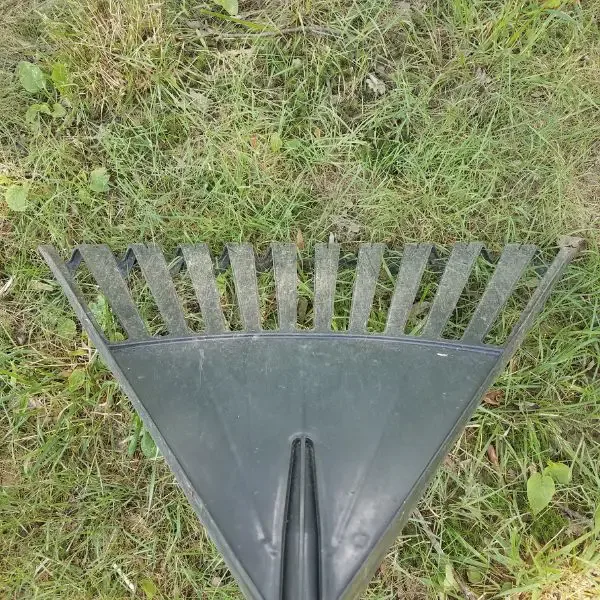
The type of material used for rakes isn’t limited to a particular rake. However, you can find a few types that commonly use a particular material. For example, garden rakes popularly use metal heads and wooden handles. Plastic is commonly used for rake heads and is prominent among roof rakes.
This is because plastic is a much lighter material and works better on roof rakes that don’t handle very heavy debris. Moreover, the lightweight nature of plastic makes it ideal for overhead use without posing serious head injury risks. When used on the roof, a plastic head rake doesn’t pose the risk of scraping or damaging the roof material, either.
Another popular rake type to use plastic is a leaf rake. Like roof rakes, leaf rakes handle lightweight leaf debris, making plastic and metal leaf rake heads more popular options. A plastic leaf rake isn’t just cheaper. It is also convenient if you only use it for lightweight materials, such as leaves.
Wood Rake
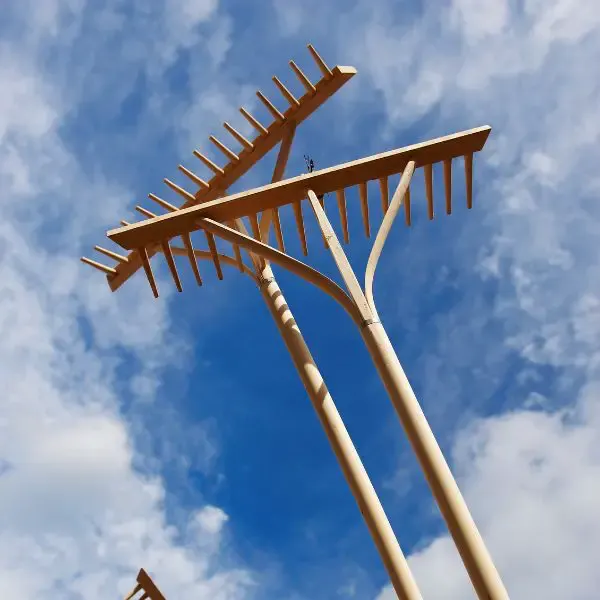
Wood is another commonly used material for rakes. However, it is more commonly used for rake handles, although you can find a few rakes with wooden teeth for roofing. Wooden rake handles are popular for their high grip and more forgiving nature on the hands.
A wooden rake handle is more responsible for fewer blisters on the hands than other materials. But, wood is susceptible to harsh outdoor conditions, especially wet conditions. So, you want to exercise extra care with a wooden rake.
Bamboo Rake
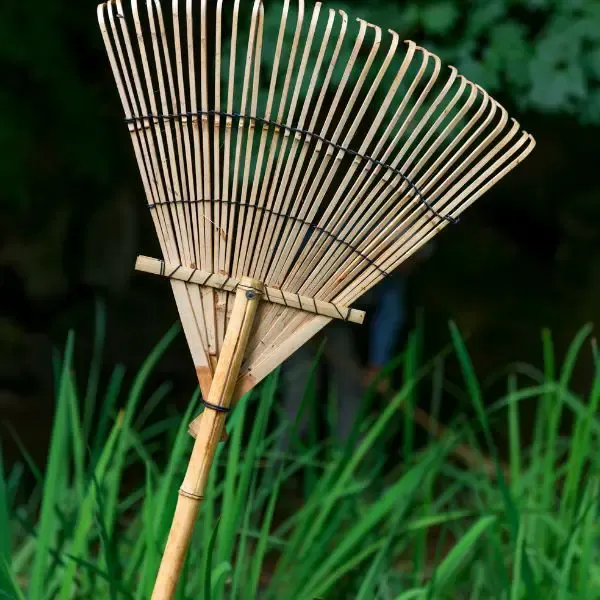
If you want a rake that’s more forgiving of the environment, a bamboo rake is an excellent option. Bamboo falls under the wood category, but it tends to be more durable and rugged, earning its own special category.
The best part of using a bamboo rake is you don’t have to further contribute to harming the environment once done using it. This is because you can add it to your compost and use it to sustain your garden when it is past its use. Nevertheless, a bamboo rake is pretty durable and comfortable to use.
Metal Rake
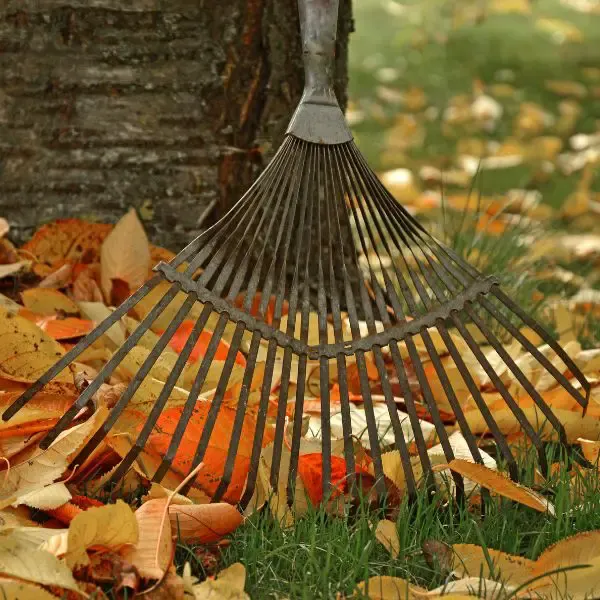
Metal rakes are the most popular and common types of rakes, used for most rake types. Metal is typically used for tines, heads, and handles. What makes this material popular is its high tensile and stable nature, preventing the heads or teeth from cracking or snapping. Further, metal rakes allow you to work on a variety of tasks, whether small or more demanding on
If you are handling heavy ground materials, such as rock, gravel, or concrete, metal is also a perfect rake material. Similarly, tasks such as soil tilling and tamping are better handled with metal rakes. Similarly, metal rakes can be expensive, competing only with wooden or bamboo rake prices.
Steel Rake
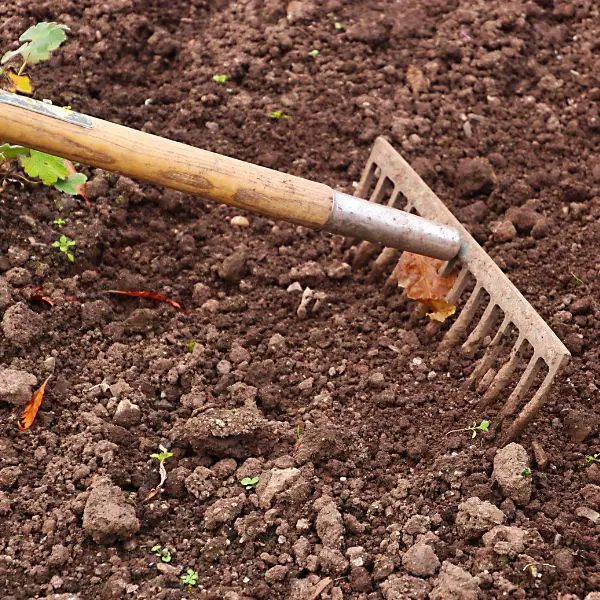
Steel is generally used for rake heads and tines. This material is favored for its ultra sturdy and rigid nature. This makes steel ideal for specialty rakes, such as thatch or stone rakes. This is because you can use the metal material for heavy jobs, like moving hard stones without the rake cracking from pressure.
Similarly, less common steel rake handles boost the rake’s weight-bearing ability and come in handy during tough jobs. However, this invaluable and longer lasting benefit also comes with a higher price tag.
Fiberglass Handle Rake
Fiberglass is generally used for rake handles. It offers a better and more comfortable form-fitting grip. Fiberglass is also lightweight yet, it handles heavy loads without snapping under pressure. But, a rake with a fiberglass handle tends to be more expensive than aluminum, steel, or plastic-handled rakes.
Frequently Asked Questions (FAQs)
Why Rake Soil?
Raking soil is essential when preparing for the next growing season by planting or seed sowing. It is also good for the plants you intend to grow in the coming growing season as it removes unwanted debris, including pest-growing havens, like deep foliage. This, in turn, protects your plants from potential diseases and microorganism activity. Plus, it’s a great way to sneak in some exercise as you improve the look and health of your yard.
Why Rake Leaves?
Leaf raking promotes ground aeration. This, in turn, protects the grass and leaves from suffocation. Further, it prevents unwanted microbial and fungal activity on the soil, which may very easily transition onto your plants.
What Rake Do I Get for Removing Dead Grass?
A leaf, lawn, bow, or thatching rake is a great option for removing dead grass. However, if the grass is on a smaller or hard-to-reach section, a hand rake is ideal. On the other hand, you can use a power rake for more convenience and thoroughness. Dead grass typically accumulates above the soil.
What Rake Do I Get for Turning Soil?
A garden or dirt rake is ideal for turning soil. Thanks to its stiff and strong design, a garden rake is specially built for preparing the garden before planting season. This makes it ideal for handling soil as you have to turn it to prepare the garden.
How Do I Care for My Rake?
You should always clean your rake before you store it after every use. A rake handles dirt and debris that can sometimes hold unwanted microorganisms. After every use, thoroughly wash the tines, scrubbing them with a gentle brush and mild soap to remove any strong residues or debris.
If it has a wooden handle, the most you can do is wipe it with a damp cloth and dry it with a dry cloth immediately after. Never wash the wooden part directly with water as this leads to swelling and rotting.
How Do I Store My Rake?
The best way to store a rake is on a rake rack or tool storage hooks in your shed or garage. With even the smallest damage to the tines, head, or handle, it may be difficult to use your rake. So, you want to protect it as much as possible. If your rake has a hanging hole, it’s best to store it by hanging it. If not, always go for racks designed for the rakes.
Conclusion
Different types of rakes exist not just for creative purposes. Every rake type is built with functionality in mind. So, whether you are an avid gardener, a serious vegetable grower, or a home improvement hobbyist, it’s good to know about the different varieties of rakes available on the market. This ultimately helps you to choose the right option so your efforts are never in vain.
Other tools

























